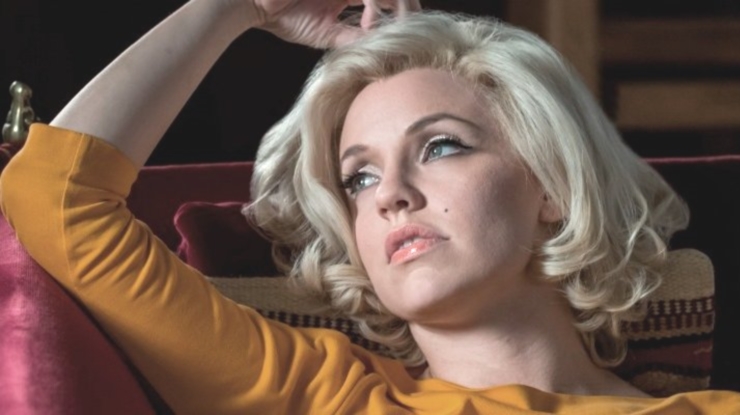The Secret Life of Marilyn Monroe
30 & 31 of May 2015
A Brief Commentary: Lifetime Television’s Mini-Series

Lifetime Television allegedly based its four hour mini-series on J. Randy Taraborrelli’s book, The Secret Life of Marilyn Monroe. I lifted the following quotation from the second page of the preface to J. Randy’s book: She often appeared open and available, as if the answer to anything you wanted to know about her was just a question away. That, though, was an illusion. You see, Marilyn Monroe had a love-hate relationship with the truth, and at times with reality itself. A kernel of truth is contained in J. Randy’s veiled assessment of Marilyn’s honesty. She often distorted her life as did the publicity department of 20th Century-Fox. Doing so was common in the fifties. Even so, Marilyn had better than just good reasons for distorting, even lying about her often difficult life.
Still, J. Randy’s soft condemnation of her distortions and prevarications is ironic, contradictory and hypocritical: he, along with everyone involved with the production of The Secret Life of Marilyn Monroe are likewise guilty of distorting, even guilty of prevaricating. Even though the program’s producers attempted to preemptively deflect any criticism for their conspicuously dishonest depiction of Marilyn Monroe’s life by confessing generally to inaccuracies and fictionalized events, they were not completely honest, not even with their odd confession. At the end of Part 1 and then again at the end of Part 2, Asylum displayed the following disclaimer: This miniseries is a dramatization based on real life persons and events. Certain scenes in the film have been fictionalized and certain time-lines have been altered for dramatic purposes. A more forthright and more accurate disclaimer would read as follows: This miniseries is a fictionalized account of Marilyn Monroe and her life, secret or otherwise, and bears no resemblance at all to the real person or to historical reality or facts and bears but a sparse resemblance to the book on which we claim it was based. I don’t necessarily want to turn this brief commentary into an accounting of Asylum’s distortions and prevarications; well, actually I do but I am going to resist the temptation. However, this must be noted: the life Asylum presents is so secret that not even Marilyn Monroe herself would recognize it. The Secret Life of Marilyn Monroe is replete with fabrications and untruths, including a shot of Marilyn in a straight-jacket as attendants toss her into a padded room.
Likewise, I don’t want to turn this commentary into a criticism of J. Randy’s biography or the reliability of his sources, second, third and fourth hand some of them; however, while the book may not be an accurate or well documented portrayal of Marilyn’s life or the woman she actually was, as many in the know contend, The Secret Life of Marilyn Monroe, the mini-series, has even less in common with the biography that shares its name than the biography has with its name sake. So the pertinent question is this: if Mr. Taraborrelli’s biography is, in fact, the well-researched cat’s meow of the Marilyn Monroe canon, as he and his publisher contend, why would he allow his work to be adulterated by Lifetime TV? Why would J. Randy, who shares writing credit along with Stephen Kronish for the teleplay, lend his name to such a corruption? Answer anyone?
Miriam-Webster’s On-Line Dictionary defines the word secret this way: kept hidden from others; known to only a few people; keeping information hidden from others; kept from knowledge or view; marked by the habit of discretion. So, when a biographer writes about a subject’s secret life, how can the biographer’s readers be certain that the biography is the actual truth and not just the biographer’s opinion or fantasy? Does it not stand to reason that a secret life would be very difficult to discover and reveal by the means of normal biographical research.
Additionally, does it not stand to reason that discovering and revealing the secret life of a person deceased for over fifty years would prove even more than difficult. The tough question is this: how would the biographer uncover the secrets? Apparently J. Randy uncovered the secrets by interviewing many friends of friends and friends of friend’s friends and the friend’s friends who worked with Gladys, Marilyn’s mother. According to J. Randy, many of his sources chose anonymity over jeopardizing their important relationships, with whom I’m not exactly sure: which important relationship would any of his unmentioned sources need to protect? We are, after all, talking about a half century after the fact. Nevertheless, J. Randy inscribed, I appreciate the assistance of many people close to Marilyn who, over the years, gave of their time for this project (Taraborrelli 503). Fair enough; but being close to Marilyn must be an approximation or a relative association in the context of J. Randy’s sources. Only three persons who were truly close to Marilyn remained alive in 2009 when J. Randy’s tome reached publication: Berniece Miracle, Marilyn’s sister, Pat Newcomb and Amy Greene. Pat Newcomb has never spoken about Marilyn and Amy Greene has never ceased speaking about her, and, some contend, not always respectfully or honestly. Marilyn’s sister, has remained virtually silent on the subject of her sister even though she and her daughter, Mona, published a brief memoir in 1994.
We must ask ourselves this, though: how did J. Randy come to write a biography about Marilyn’s secret life? Well, he tells us:
… at the very beginning of this project, I sat down with my researchers and investigators and posed the very important question: What is there about Marilyn Monroe that has not been reported in about a hundred other books about her? It took us some time to answer that question … it was the relationship between Marilyn and her mother, Gladys Baker, that began to most fascinate me as we continued our research, and I soon realized that it was one of the stories I most wanted to tell on these pages—because it had never before been told (Taraborrelli 499).
An untold story about a secret life just waiting to be told. Could it be that J. Randy developed a premise and then used all the clairvoyance at his disposal to prove it? In honesty I must admit, I do not disagree with every opinion about Marilyn posited by J. Randy; I just disagree with the practice of representing posited opinions as facts.
My mother raised me up to say something good, if possible, or to say nothing at all, an admirable principle; but in the case of Marilyn’s secret life, a principle that seems more than silly and virtually impossible to follow; but to honor my dear mom, I’ll offer a few relatively positive comments now.
The musical score, what there is of it, is unmemorable but acceptable.
The movie’s cinematography is lush along with the set decoration and the art direction.
The lighting techniques used by Laurie Collyer, the director, and Chris Manley, the cinematographer, infuse the scenes with a certain film noir moodiness along with an undercurrent of danger and an atmosphere of impending doom, reflecting Marilyn’s depicted descent into insanity and her impending death.
Gersha Phillips’ costume design is also lush and the production faithfully reproduced the many now famous gowns and dresses worn by Marilyn.
I would like to say something good about the performances delivered by the cast members; but then I would be guilty of lying, something my mother admonished me to avoid. To compliment the acting, I would have to forsake any contact with reality itself, not unlike the delineation of the movie’s characters.
Each performer appears in a fictionalized form of a various person who was influential in Marilyn’s life and career: James Dougherty, Grace McKee, Joseph Schneck, Johnny Hyde, Joe DiMaggio, Natasha Lytess, Arthur Miller and several others. Unfortunately, they are mostly distorted sketches and Marilyn’s relationship with them are equally distorted, particularly her relationship with Arthur Miller and Gladys.
In my opinion, Susan Sarandon is arguably one of the most overrated actresses in the history of overrated actresses. Her Gladys is a caricature at best. Admittedly, I cannot completely blame Susan for her cartoonesque Gladys. After all, she didn’t write the part; and in truth, not much is known about Gladys Pearl Monroe. She spent most of her life institutionalized, beginning in 1938 when Norma Jeane was eight years old. Marilyn was not around her mother that frequently or that much. The mother-daughter relationship that Taraborrelli and Kronish et al. created for Marilyn’s secret life is utterly fictitious. Well, alright. Perhaps I am being harsh and judgmental: they created a secret relationship that nobody―and I mean nobody, save for Randy’s mysterious sources―ever knew existed.
Kelli Garner was terrific in Man of the House. Likewise, she was terrific in Lars and the Real Girl. But portraying the world’s most celebrated female Icon requires more than a breathy voice and big breasts, an ample derriere and blonde curls. Kelli resembles Marilyn for true and while she is certainly voluptuous, she is actually much thicker than the world’s sex symbol. I’m not going to criticize her for lacking Marilyn’s screen presence or her amazing lambency because Kelli is not Marilyn Monroe; but her vocal affectation is wrong as is her cadence and her line delivery. In her voice, there is always the tinge of whining, something completely missing from Marilyn’s. Kelli tries admirably to emulate the vulnerable sexuality that emanated effortlessly from Marilyn; but despite her ardent efforts, she falls well short of success. Kelli’s Marilyn is meretricious. That is not totally Kelli’s fault, I admit: the teleplay clearly suggests the world’s most famous movie star slept her way to stardom and was just this side of being a pro. For fornicating with Mr. Schneck, had she accepted some folding money instead of her four second walk by role in Scudda Hoo! Scudda Hay!, she would have been just that: a prostitute.
But the real dereliction is not with the disingenuous characterizations of the persons included. That is certainly bad enough; but the real cinematic malpractice rests in the many influential persons in Marilyn’s real life that the teleplay’s producers and writers chose to omit.
Oddly enough, Grace’s aunt, Ana Lower, with whom Marilyn lived, a woman she deeply loved, gets summarily ignored, as does Bernice Baker Miracle, Marilyn’s half-sister with whom she had a significant relationship. J. Randy notes that he relied heavily on Berniece’s memoir but not enough, apparently, to include her in her sister’s secret life. One of Marilyn’s closest friends and confidants, Ralph Roberts, her personal masseur, is never mentioned. Also absent are Lee, Paula and Susan Strasberg, three significant and influential persons in Marilyn’s life and career. J. Randy claims that he interviewed Susan in 1997. I can only assume that she is missing from Marilyn’s secret life because she did not know anything about it. After Marilyn left Hollywood for Manhattan, however, and entered into her relationship with the Actor’s Studio in 1955, the Strasbergs became her surrogate family. Marilyn even shared a bedroom with Susan. But perhaps the most glaring omissions are lens man Milton Greene and his wife, Amy. Not only did Milton photograph Marilyn numerous times, capture some of the more enduring and artistic images of her, she lived with Milton and Amy briefly in Connecticut after she fled Hollywood in 1954. Milton became vice-president of Marilyn Monroe Productions, the production company he co-founded with Marilyn to give her more control over her roles and her career. A significant venture for a woman in the fifties, not mentioned at all; and speaking of not mentioned at all, Marilyn’s cinematic career, obviously not a part of her secret life, gets summarily ignored.
Why did the teleplay’s producers and writers omit all those important persons and the significant event of being only the second woman in Tinsel town, after Mary Pickford, to form her own production company? I could offer a few reasons why; but to do so would be to engage in high conjecture and high criticism and I don’t want to emulate Lifetime Television. I will just assume those individuals simply were not involved in, and the founding of Marilyn Monroe Productions simply did not happen during, the moments when Marilyn Monroe lived her secret life.
Those in the know knew The Secret Life of Marilyn Monroe would end tragically; but not one person on this rotating orb, not even the Pope himself, knows what happened in Marilyn’s bedroom on the evening of August the 4th in 1962. Yet, the producers and the writers of the teleplay chose to depict her staggering around with a bottle, washing down those deadly prescription drugs with a glass of whiskey. Marilyn’s autopsy revealed she was not imbibing the night of her death; but what does that matter to Tinsel town television fantasists?
So Marilyn’s secret life closes and ends with the image of her as a desperately obsessed, drug addled alcoholic nearing insanity who possibly chose to die as a way out of her misery. Sadly, the awful impact of Marilyn’s untimely death does not receive as little as a single note. Humanity lost someone who, and something that, can never be replaced; and the world’s greatest movie star deserved, and deserves, something much much better than Lifetime’s insulting fabrication.


